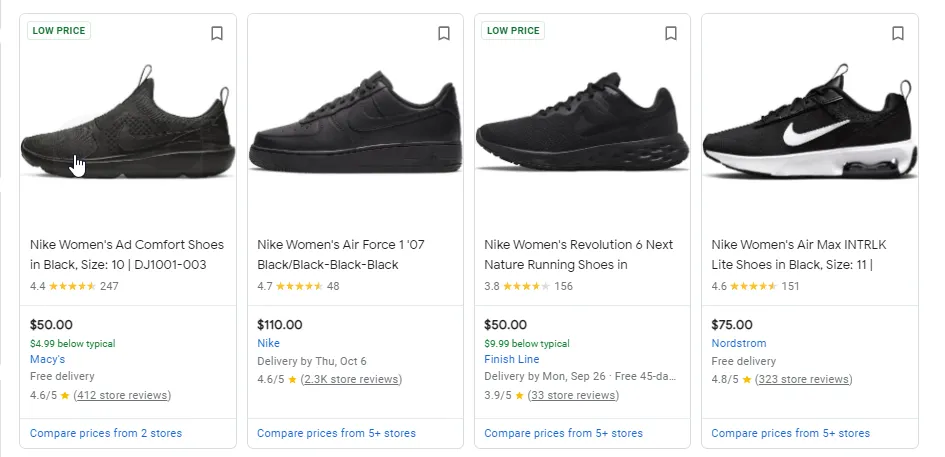Along with shorter days, cooler temps, and the first day of Fall, September ushers in the highly anticipated pre-holiday shopping season. It kicks off with back-to-school, picks up momentum around Halloween, and peaks with the two busiest online shopping days of the year – Black Friday and Cyber Monday.
Statistics show that most consumer spending occurs during the Fall months, and consumer behavior surveys confirm what we already know – shoppers are highly motivated and heavily influenced to spend during this time of year.
Here are some compelling shopping stats:
- In 2021 61% of shoppers surveyed started their holiday shopping before November
- 51% of consumers are planning to shop earlier because they are concerned about product availability due to the supply-chain shortages that occurred this year
- 85% of consumers plan to shop mostly online for the holidays this year, up from 80% last year
- 29% of consumers are planning to spend more this season than they did last year
- Social media channels will influence 58% of consumer buying decisions this year, and Facebook will be the #1 social platform influencing consumer purchases
Benefits of applying seasonal data feed optimizations
The pre-holiday season is the time to capitalize on the fact that shoppers who intend to spend big will be flooding shopping channels like Google Shopping, Facebook, and Amazon.
Optimizing your product data at the feed-level at the beginning of this season gives your store the opportunity to increase sales volume by:
Targeting highly-motivated audiences
Not only does the audience size grow exponentially during the pre-holiday season… shoppers’ motivation to buy peaks, too. Implementing feed optimizations will improve your listing performance and make your products more attractive to highly-motivated shoppers.
Clearing old inventory
Shoppers will be searching in earnest for the best deal during the next few months, making the pre-holiday season a prime time to move last season’s items or boost that lingering collection of products that sold at a slower rate than the rest of your catalog.
Promoting new & in-demand products
If you have new products or products that are on-trend and in-demand this year, you need to be optimizing and grouping these products in your feeds to power your pre-holiday season shopping campaigns.

Data feed optimizations that help your products compete
Most ecommerce advertisers ramp up their campaign spending starting in September, so seasonal optimization of your data feed should be an integral part of your Q4 strategy to remain competitive in your product space.
Harness the Power of Your Product Data
Revisiting your catalog data can lead you to discover new, existing, or updatable attributes you can leverage in your data feeds to create more competitive product listings and ads.
Here are some key data attributes to review in your catalog:
Include product differentiators in your product titles
Shopping channels like Google highly value optimized titles when it comes to determining product listing and ad placement, so assigning product differentiating attributes to your titles can improve SERP rank. Introducing more granularity in your product titles is an effective spending control mechanism, too, because clicks will stem from customers in search of particular variations within your catalog.
Also, optimizing your titles helps your listings and Ads resonate with customers searching for products like yours during the pre-holiday season when they are bombarded by millions of products. Including product differentiators like brand, product size, color or other product-specific attributes to help your products stand out amongst your competitors’ products.
Dress up your descriptions
While product features remain pretty consistent year-round, the pre-holiday season is a great time to include even more benefits and features into your descriptions to tell customers why they should buy this product – and more importantly – why they should buy it from you.
Combine additional keywords or text in the description feed field to give your listings’ performance a boost in quality score. Include phrases that differentiate your products, or language that differentiates your company as a whole. For example, “100% hand-made”, “Guaranteed delivery before…”, or insert language outlining your product satisfaction guarantee.
Introduce sale price information or seasonal promotions
‘Tis the season for discounts, so it’s not really a matter of if you should include sale price or seasonal promotions in your feed, it’s a matter of when. You’ll want to aim for the sweet spot in the pre-holiday season that introduces your sales a smidge earlier than a majority of your competition, but not too long before customers are planning to ramp up their spending. You may even consider throttling the submission of your seasonal promotions or sales price among particular product groups before applying to all products.
Assign custom labels
Custom labels allow you to group products so they are easily identifiable and assignable within your pre-holiday Shopping campaigns. Google Shopping feeds include 5 custom_label fields, so you can create 5 groups of products, 1 under each custom label. Here are some examples of common custom label groups for the pre-holiday season:
- best selling products
- products with the highest-margins
- clearance products
- seasonal products
- custom products
How to optimize your data feeds and group products for shopping campaigns
Step one: open your product catalog data.
Become familiar with the product attributes you have readily available to include that can further optimize in your data feeds. Your catalog review may uncover missing product attributes – or missing values for product attributes – that you need to revise on the catalog level (or introduce at the feed-level) in order to implement the feed optimizations detailed below.
Prioritize product titles
Shoppers are well-informed about how to find what they’re looking for, fast. They’ve fully harnessed the power of the search bar. They are clearly defining the product variation they need and quickly scan product titles for their perfect match.
Along with ensuring your product titles align with shopper product search behavior, optimizing your titles improves your products’ quality score.
Concatenate product attributes to increase granularity, improve listing appearance, and enhance ad and listing performance
You don’t need to spend hours writing optimized titles for your data feeds this pre-holiday season. You can quickly and easily concatenate common product attributes using a feed management tool to add key feed attributes like: brand, product name, size, color, gender, format, and sale price into your feeds’ title field.
Including details in your product titles will fully and quickly inform customers about your products as they scan through shopping results, ensuring you target the right customers.
Use static text values, text separators, and symbols to make sure your titles are easily readable and stand out amongst the sea of competitor listings – like the Shopping results for “nike women’s shoes” displayed below.

Concatenated title formatting examples
[BRAND] + [GENDER]+ "'s" + [COLOR] + [TITLE] + “-” "Size" + [SIZE] will produce the following example product title:
Nike Women’s Black Marathon Training Sneaker - Size 6
[BRAND] + “|” [GENDER]+ [TITLE] + "in'' + [COLOR] “-” [SALEPRICE] will produce the following example product title:
Cartier | Unisex Diamond Stud Earrings in Gold - $2499

Enhance product descriptions with more product features and/or company differentiators
Not that you’ve optimized your titles to target highly-motivated customers searching for products like yours, enhance your product descriptions to inform customers about why they should buy from your store. Optimizing your product descriptions also gives listing performance and rank a boost, too.
Inject keywords highlighting product benefits and features, or add company differentiators or phrases that create a sense of urgency to your descriptions to further distinguish your catalog (and company) from thousands of other sellers in your space.
Similar to optimizing your titles, you can quickly and easily insert keywords in the form of static text to some or all of your products using a feed management tool like GoDataFeed.
Product benefits & features format examples
“100% hand-made in the USA -” + [DESCRIPTION] will produce the following example description:
100% hand-made in the USA - This ivory ceramic bowl with intricate flower stenciling serves as a beautiful centerpiece and functional piece of dinnerware.
“SALE - Limited Time Only.” + [DESCRIPTION] will produce the following example description:
SALE - Limited Time Only. The Playstation 4 combines the elements of a central processing unit (CPU) and graphics processing unit (GPU) to power your play.

[DESCRIPTION] + “Free, no contact delivery available.” + “Guaranteed delivery before the holidays.” will produce the following example description:
This Samsung Infinity Screen Smart TV boasts our slimmest profile ever. Get ready for an immersive & epic viewing experience. Free, no contact delivery available. Guaranteed delivery before the holidays.
[DESCRIPTION] + “10% of all proceeds donated to the Clean Air Task Force.” will produce the following example description:
Our reusable 25ml BPA-free water bottle is constructed of 18/8 stainless steel and comes with an optional crossbody strap. 10% of all proceeds donated to the Clean Air Task Force.
Include or calculate sale price information in your data feeds
Sale price isn’t a required feed field amongst the leading shopping channels… but when the pre-holiday season comes around, submitting sale price in data feeds becomes industry standard.
You can map in the sale price product attribute within your catalog to your data feeds– or, if you don’t have sale price values available in your catalog – you utilize a calculator function like the one available in GoDataFeed to calculate sale price as a discount of your regular price values.
Calculate sale price utilizing a calculator function
Adding a discount to some or all products in your catalog using a calculator function is a lot simpler than you think. Most of the top feed management tools use similar calculator function logic, allowing sellers to apply a discount to some or all of their products’ price value and submit this calculated sale price in their data feeds.
Calculator function using GoDataFeed to discount price by 30%:
Set the feed’s [sale_price] to [[ [P].[price] * .7 ]]:

Group products for your campaigns using Custom Labels
There are five custom labels (0-4) that allow you to group your products into categories for your shopping campaigns – making it easy to locate, bid on, and obtain reporting for these product groups.
Use Custom Labels
The custom label you apply within your data feed will not be visible to customers in your shopping ads, so name each custom label something relative to the assigned group of products for easy identification by you or your Team. Then, create the logic that will assign the custom label to the intended products based on data points available in your catalog.
Custom label example using GoDataFeed to group sale products:
For this example we have identified that some products have sale price values available within the product catalog, so we can set custom_label_0 to “Sale Products” in our catalog and add conditional logic to apply this custom label to products when their sale price field is not empty.

Summary
Fall brings us sweater weather, pumpkin spice, and an uptick in shopping. Enhanced product listings become even more important as shoppers cozy up to their laptops and mobile devices — and competitors ratchet up their ad spend.
Using seasonal data feed optimization tactics like these will give your products the edge when it matters most.
Need some more product optimization ideas? Download our Cheat Sheet.







